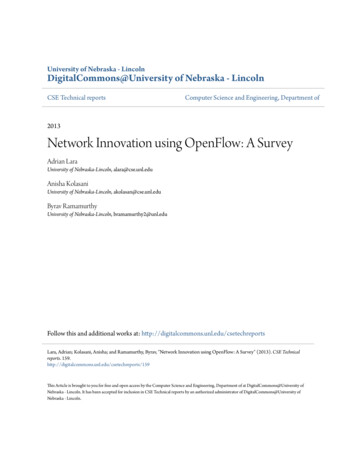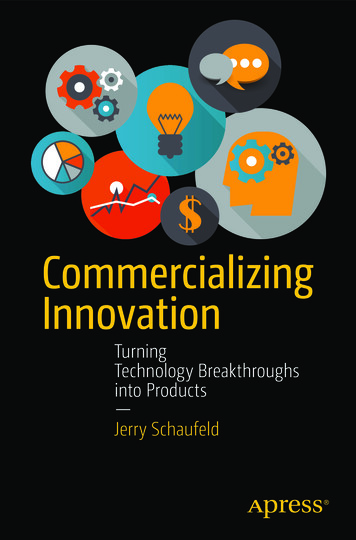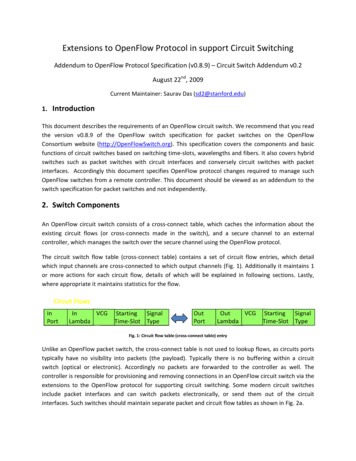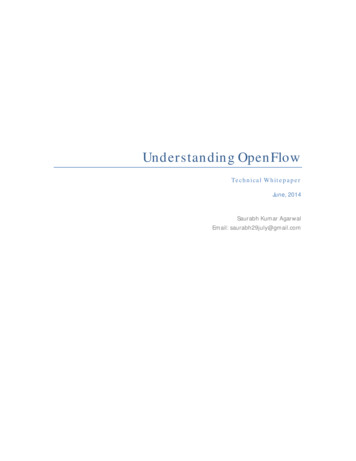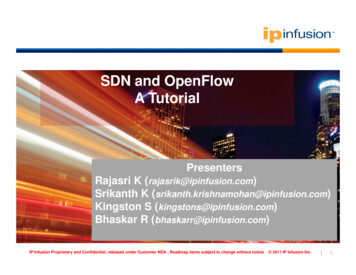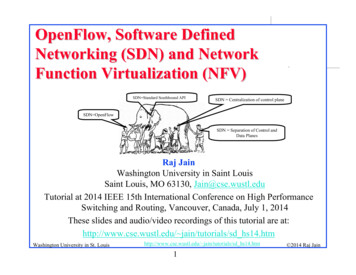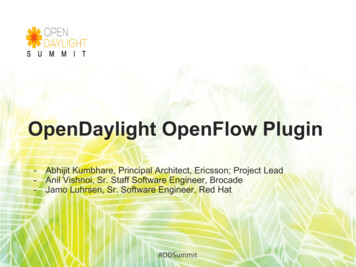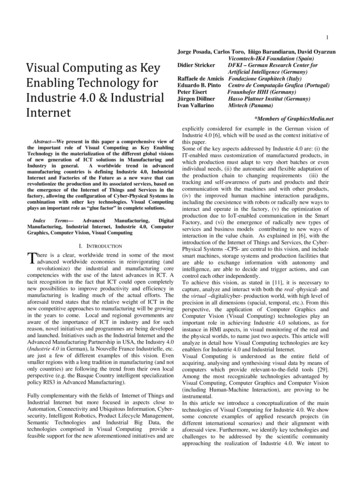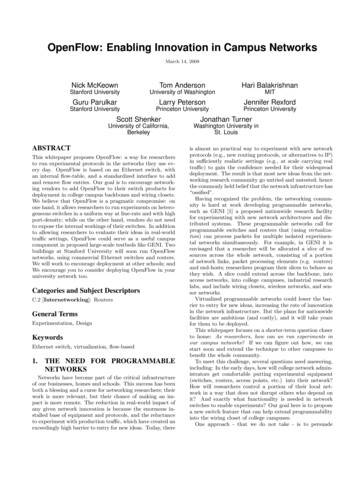
Transcription
OpenFlow: Enabling Innovation in Campus NetworksMarch 14, 2008Nick McKeownTom AndersonHari BalakrishnanStanford UniversityUniversity of WashingtonMITGuru ParulkarLarry PetersonJennifer RexfordStanford UniversityPrinceton UniversityPrinceton UniversityScott ShenkerJonathan TurnerUniversity of California,BerkeleyWashington University inSt. LouisABSTRACTThis whitepaper proposes OpenFlow: a way for researchersto run experimental protocols in the networks they use every day. OpenFlow is based on an Ethernet switch, withan internal flow-table, and a standardized interface to addand remove flow entries. Our goal is to encourage networking vendors to add OpenFlow to their switch products fordeployment in college campus backbones and wiring closets.We believe that OpenFlow is a pragmatic compromise: onone hand, it allows researchers to run experiments on heterogeneous switches in a uniform way at line-rate and with highport-density; while on the other hand, vendors do not needto expose the internal workings of their switches. In additionto allowing researchers to evaluate their ideas in real-worldtraffic settings, OpenFlow could serve as a useful campuscomponent in proposed large-scale testbeds like GENI. Twobuildings at Stanford University will soon run OpenFlownetworks, using commercial Ethernet switches and routers.We will work to encourage deployment at other schools; andWe encourage you to consider deploying OpenFlow in youruniversity network too.Categories and Subject DescriptorsC.2 [Internetworking]: RoutersGeneral TermsExperimentation, DesignKeywordsEthernet switch, virtualization, flow-based1.THE NEED FOR PROGRAMMABLENETWORKSNetworks have become part of the critical infrastructureof our businesses, homes and schools. This success has beenboth a blessing and a curse for networking researchers; theirwork is more relevant, but their chance of making an impact is more remote. The reduction in real-world impact ofany given network innovation is because the enormous installed base of equipment and protocols, and the reluctanceto experiment with production traffic, which have created anexceedingly high barrier to entry for new ideas. Today, thereis almost no practical way to experiment with new networkprotocols (e.g., new routing protocols, or alternatives to IP)in sufficiently realistic settings (e.g., at scale carrying realtraffic) to gain the confidence needed for their widespreaddeployment. The result is that most new ideas from the networking research community go untried and untested; hencethe commonly held belief that the network infrastructure has“ossified”.Having recognized the problem, the networking community is hard at work developing programmable networks,such as GENI [1] a proposed nationwide research facilityfor experimenting with new network architectures and distributed systems. These programmable networks call forprogrammable switches and routers that (using virtualization) can process packets for multiple isolated experimental networks simultaneously. For example, in GENI it isenvisaged that a researcher will be allocated a slice of resources across the whole network, consisting of a portionof network links, packet processing elements (e.g. routers)and end-hosts; researchers program their slices to behave asthey wish. A slice could extend across the backbone, intoaccess networks, into college campuses, industrial researchlabs, and include wiring closets, wireless networks, and sensor networks.Virtualized programmable networks could lower the barrier to entry for new ideas, increasing the rate of innovationin the network infrastructure. But the plans for nationwidefacilities are ambitious (and costly), and it will take yearsfor them to be deployed.This whitepaper focuses on a shorter-term question closerto home: As researchers, how can we run experiments inour campus networks? If we can figure out how, we canstart soon and extend the technique to other campuses tobenefit the whole community.To meet this challenge, several questions need answering,including: In the early days, how will college network administrators get comfortable putting experimental equipment(switches, routers, access points, etc.) into their network?How will researchers control a portion of their local network in a way that does not disrupt others who depend onit? And exactly what functionality is needed in networkswitches to enable experiments? Our goal here is to proposea new switch feature that can help extend programmabilityinto the wiring closet of college campuses.One approach - that we do not take - is to persuade
commercial “name-brand” equipment vendors to provide anopen, programmable, virtualized platform on their switchesand routers so that researchers can deploy new protocols,while network administrators can take comfort that theequipment is well supported. This outcome is very unlikelyin the short-term. Commercial switches and routers do nottypically provide an open software platform, let alone provide a means to virtualize either their hardware or software.The practice of commercial networking is that the standardized external interfaces are narrow (i.e., just packet forwarding), and all of the switch’s internal flexibility is hidden. Theinternals differ from vendor to vendor, with no standardplatform for researchers to experiment with new ideas. Further, network equipment vendors are understandably nervous about opening up interfaces inside their boxes: theyhave spent years deploying and tuning fragile distributedprotocols and algorithms, and they fear that new experiments will bring networks crashing down. And, of course,open platforms lower the barrier-to-entry for new competitors.A few open software platforms already exist, but do nothave the performance or port-density we need. The simplestexample is a PC with several network interfaces and an operating system. All well-known operating systems supportrouting of packets between interfaces, and open-source implementations of routing protocols exist (e.g., as part of theLinux distribution, or from XORP [2]); and in most cases itis possible to modify the operating system to process packetsin almost any manner (e.g., using Click [3]). The problem,of course, is performance: A PC can neither support thenumber of ports needed for a college wiring closet (a fanoutof 100 ports is needed per box), nor the packet-processingperformance (wiring closet switches process over 100Gbits/sof data, whereas a typical PC struggles to exceed 1Gbit/s;and the gap between the two is widening).Existing platforms with specialized hardware for line-rateprocessing are not quite suitable for college wiring closets either. For example, an ATCA-based virtualized programmable router called the Supercharged PlanetLab Platform [4] is under development at Washington University,and can use network processors to process packets frommany interfaces simultaneously at line-rate. This approachis promising in the long-term, but for the time being is targeted at large switching centers and is too expensive forwidespread deployment in college wiring closets. At theother extreme is NetFPGA [5] targeted for use in teachingand research labs. NetFPGA is a low-cost PCI card witha user-programmable FPGA for processing packets, and 4ports of Gigabit Ethernet. NetFPGA is limited to just fournetwork interfaces—insufficient for use in a wiring closet.Thus, the commercial solutions are too closed and inflexible, and the research solutions either have insufficient performance or fanout, or are too expensive. It seems unlikelythat the research solutions, with their complete generality,can overcome their performance or cost limitations. A morepromising approach is to compromise on generality and toseek a degree of switch flexibility that is: Amenable to high-performance and low-cost implementations. Capable of supporting a broad range of research. Assured to isolate experimental traffic from productiontraffic.Scope of OpenFlow Switch SpecificationOpenFlowSwitchsw SecureChannelOpenFlowProtocolSSLControllerPChw FlowTableFigure 1: Idealized OpenFlow Switch. The FlowTable is controlled by a remote controller via theSecure Channel. Consistent with vendors’ need for closed platforms.This paper describes the OpenFlow Switch—a specification that is an initial attempt to meet these four goals.2. THE OPENFLOW SWITCHThe basic idea is simple: we exploit the fact that mostmodern Ethernet switches and routers contain flow-tables(typically built from TCAMs) that run at line-rate to implement firewalls, NAT, QoS, and to collect statistics. Whileeach vendor’s flow-table is different, we’ve identified an interesting common set of functions that run in many switchesand routers. OpenFlow exploits this common set of functions.OpenFlow provides an open protocol to program the flowtable in different switches and routers. A network administrator can partition traffic into production and researchflows. Researchers can control their own flows - by choosingthe routes their packets follow and the processing they receive. In this way, researchers can try new routing protocols,security models, addressing schemes, and even alternativesto IP. On the same network, the production traffic is isolatedand processed in the same way as today.The datapath of an OpenFlow Switch consists of a FlowTable, and an action associated with each flow entry. Theset of actions supported by an OpenFlow Switch is extensible, but below we describe a minimum requirement forall switches. For high-performance and low-cost the datapath must have a carefully prescribed degree of flexibility.This means forgoing the ability to specify arbitrary handlingof each packet and seeking a more limited, but still useful,range of actions. Therefore, later in the paper, define a basicrequired set of actions for all OpenFlow switches.An OpenFlow Switch consists of at least three parts: (1)A Flow Table, with an action associated with each flow entry, to tell the switch how to process the flow, (2) A SecureChannel that connects the switch to a remote control process (called the controller), allowing commands and packets
to be sent between a controller and the switch using (3) TheOpenFlow Protocol, which provides an open and standardway for a controller to communicate with a switch. By specifying a standard interface (the OpenFlow Protocol) throughwhich entries in the Flow Table can be defined externally,the OpenFlow Switch avoids the need for researchers to program the switch.It is useful to categorize switches into dedicated OpenFlowswitches that do not support normal Layer 2 and Layer 3processing, and OpenFlow-enabled general purpose commercial Ethernet switches and routers, to which the OpenFlow Protocol and interfaces have been added as a new feature.Dedicated OpenFlow switches. A dedicated OpenFlowSwitch is a dumb datapath element that forwards packetsbetween ports, as defined by a remote control process. Figure 1 shows an example of an OpenFlow Switch.In this context, flows are broadly defined, and are limitedonly by the capabilities of the particular implementation ofthe Flow Table. For example, a flow could be a TCP connection, or all packets from a particular MAC address orIP address, or all packets with the same VLAN tag, or allpackets from the same switch port. For experiments involving non-IPv4 packets, a flow could be defined as all packetsmatching a specific (but non-standard) header.Each flow-entry has a simple action associated with it;the three basic ones (that all dedicated OpenFlow switchesmust support) are:1. Forward this flow’s packets to a given port (or ports).This allows packets to be routed through the network.In most switches this is expected to take place at linerate.2. Encapsulate and forward this flow’s packets to a controller. Packet is delivered to Secure Channel, whereit is encapsulated and sent to a controller. Typicallyused for the first packet in a new flow, so a controllercan decide if the flow should be added to the FlowTable. Or in some experiments, it could be used toforward all packets to a controller for processing.3. Drop this flow’s packets. Can be used for security, tocurb denial of service attacks, or to reduce spuriousbroadcast discovery traffic from end-hosts.An entry in the Flow-Table has three fields: (1) A packetheader that defines the flow, (2) The action, which defineshow the packets should be processed, and (3) Statistics,which keep track of the number of packets and bytes foreach flow, and the time since the last packet matched theflow (to help with the removal of inactive flows).In the first generation “Type 0” switches, the flow headeris a 10-tuple shown in Table 1. A TCP flow could be specified by all ten fields, whereas an IP flow might not includethe transport ports in its definition. Each header field canbe a wildcard to allow for aggregation of flows, such as flowsin which only the VLAN ID is defined would apply to alltraffic on a particular VLAN.The detailed requirements of an OpenFlow Switch are defined by the OpenFlow Switch Specification [6].OpenFlow-enabled switches.Some commercialswitches, routers and access points will be enhanced stTable 1: The header fields matched in a “Type 0”OpenFlow switch.the OpenFlow feature by adding the Flow Table, SecureChannel and OpenFlow Protocol (we list some examples inSection 5). Typically, the Flow Table will re-use existinghardware, such as a TCAM; the Secure Channel and Protocol will be ported to run on the switch’s operating system.Figure 2 shows a network of OpenFlow-enabled commercialswitches and access points. In this example, all the FlowTables are managed by the same controller; the OpenFlowProtocol allows a switch to be controlled by two or morecontrollers for increased performance or robustness.Our goal is to enable experiments to take place in an existing production network alongside regular traffic and applications. Therefore, to win the confidence of network administrators, OpenFlow-enabled switches must isolate experimental traffic (processed by the Flow Table) from production traffic that is to be processed by the normal Layer 2and Layer 3 pipeline of the switch. There are two ways toachieve this separation. One is to add a fourth action:4. Forward this flow’s packets through the switch’s normal processing pipeline.The other is to define separate sets of VLANs for experimental and production traffic. Both approaches allow normal production traffic that isn’t part of an experiment to beprocessed in the usual way by the switch. All OpenFlowenabled switches are required to support one approach orthe other; some will support both.Additional features. If a switch supports the header formats and the four basic actions mentioned above (and detailed in the OpenFlow Switch Specification), then we call ita “Type 0” switch. We expect that many switches will support additional actions, for example to rewrite portions ofthe packet header (e.g., for NAT, or to obfuscate addresseson intermediate links), and to map packets to a priorityclass. Likewise, some Flow Tables will be able to match onarbitrary fields in the packet header, enabling experimentswith new non-IP protocols. As a particular set of featuresemerges, we will define a “Type 1” switch.Controllers. A controller adds and removes flow-entriesfrom the Flow Table on behalf of experiments. For example,a static controller might be a simple application runningon a PC to statically establish flows to interconnect a setof test computers for the duration of an experiment. Inthis case the flows resemble VLANs in current networks—providing a simple mechanism to isolate experimental trafficfrom the production network. Viewed this way, OpenFlowis a generalization of VLANs.One can also imagine more sophisticated controllers thatdynamically add/remove flows as an experiment progresses.In one usage model, a researcher might control the completenetwork of OpenFlow Switches and be free to decide how allflows are processed. A more sophisticated controller mightsupport multiple researchers, each with different accountsand permissions, enabling them to run multiple independent experiments on different sets of flows. Flows identified
Server roomControllerOpenFlowAccess mercial owFlowTableTableSecureSecureaddressed in the context of the Ethane prototype, whichused simple flow switches and a central controller [7]. Preliminary results suggested that an Ethane controller basedon a low-cost desktop PC could process over 10,000 newflows per second — enough for a large college campus. Ofcourse, the rate at which new flows can be processed will depend on the complexity of the processing required by the researcher’s experiment. But it gives us confidence that meaningful experiments can be run. Scalability and redundancyare possible by making a controller (and the experiments)stateless, allowing simple load-balancing over multiple separate devices.3.1 Experiments in a Production NetworkChances are, Amy is testing her new protocol in a networkused by lots of other people. We therefore want the networkto have two additional properties:1. Packets belonging to users other than Amy should berouted using a standard and tested routing protocolrunning in the switch or router from a “name-brand”vendor.2. Amy should only be able to add flow entries for hertraffic, or for any traffic her network administrator hasallowed her to control.Figure 2: Example of a network of OpenFlowenabled commercial switches and routers.as under the control of a particular researcher (e.g., by apolicy table running in a controller) could be delivered to aresearcher’s user-level control program which then decides ifa new flow-entry should be added to the network of switches.3.USING OPENFLOWAs a simple example of how an OpenFlow Switch might beused imagine that Amy (a researcher) invented Amy-OSPFas a new routing protocol to replace OSPF. She wants totry her protocol in a network of OpenFlow Switches, without changing any end-host software. Amy-OSPF will run ina controller; each time a new application flow starts AmyOSPF picks a route through a series of OpenFlow Switches,and adds a flow- entry in each switch along the path. In herexperiment, Amy decides to use Amy-OSPF for the trafficentering the OpenFlow network from her own desktop PC—so she doesn’t disrupt the network for others. To do this,she defines one flow to be all the traffic entering the OpenFlow switch through the switch port her PC is connected to,and adds a flow-entry with the action “Encapsulate and forward all packets to a controller”. When her packets reacha controller, her new protocol chooses a route and adds anew flow-entry (for the application flow) to every switchalong the chosen path. When subsequent packets arrive ata switch, they are processed quickly (and at line-rate) bythe Flow Table.There are legitimate questions to ask about the performance, reliability and scalability of a controller that dynamically adds and removes flows as an experiment progresses:Can such a centralized controller be fast enough to processnew flows and program the Flow Switches? What happenswhen a controller fails? To some extent these questions wereProperty 1 is achieved by OpenFlow-enabled switches.In Amy’s experiment, the default action for all packetsthat don’t come from Amy’s PC could be to forward themthrough the normal processing pipeline. Amy’s own packetswould be forwarded directly to the outgoing port, withoutbeing processed by the normal pipeline.Property 2 depends on the controller. The controllershould be seen as a platform that enables researchers to implement various experiments, and the restrictions of Property 2 can be achieved with the appropriate use of permissions or other ways to limit the powers of individual researchers to control flow entries. The exact nature
Scope of OpenFlow Switch Specification Figure 1: Idealized OpenFlow Switch. The Flow Table is controlled by a remote controller via the Secure Channel. Consistent with vendors’ need for closed platforms. This paper describes the OpenFlow Switch—a specifica-tion that is an initial attempt to meet these four goals. 2. THE OPENFLOW SWITCH
